
Tackling the Immigration Issue in Micro-Macro Debates (Pt. 1)
Overview
Thanks largely to the 2016 presidential election, the immigration debate in the U.S. has exploded. What has always been a controversial and multi-faceted issue — literally since the founding of the nation — has become a politically contentious, widely-protested, and complex debate, being played out everywhere from the halls of power in D.C. to the nation’s airports to small town and mid-size city public squares to social media platforms of all kinds.
Argument-Centered Education sees in the public controversy over immigration an excellent opportunity to harness its energy, urgency, and immediacy for the benefit of social science or even informational text oriented English language arts instruction. By bringing crucial debates such as this one into our classrooms, we teach students the critical thinking and critical literacy skills that they need — that our society needs — to pursue truth, to distinguish fact from propaganda and spin, to make rational and evidence-based evaluations and judgments. Students become better citizens this way, and they are more likely to be civically engaged. And bringing debates into the classroom lets us have our cake while we eat it too: these are the same college-directed reasoning and evidence-evaluation habits of thinking that standardized testing — PARCC, Smarter Balanced, the New SAT, the PSAT, the latest iterations of the ACT — are increasingly designed around. Well-designed and effectively implemented argumentation curriculum on a complex issue like immigration is the key to both civic engagement and college readiness.
Getting Our Arms Around Immigration in the Classroom
But is the immigration debate simply too large, too complicated, to handle in a 6th – 12th grade classroom? It can be, and we have seen teachers struggle with it, conducting debates and structured argumentation activities that are unfocused and superficial. However, Argument-Centered Education has designed a debating format that is specially capable of accommodating large and complex issues such as immigration. It is called Micro-Macro Debates, and we have been successfully supporting its implementation at schools across our partnership network this year. Micro-Macro Immigration Debates begin, as almost all argument-centered instruction does, with a debatable issue.
Should the United States substantially restrict immigration?
The full Micro-Macro Debates format is laid out below, but the most distinctive feature is that the issue is divided up into a number of sub-issues which groups of students are assigned to debate, on either the affirmative or the negative. The six sub-issues for our Micro-Macro Immigration Debates are:
Economic Impact Overall
High-Skilled Immigrants
Humanitarianism (Refugees)
Social Division/Diversity
Terrorism
Wages/Unemployment
Dividing the Issue into Sub-Issues and Providing Claims
The class is divided into two halves — affirmative and negative on the issue — and then each half is divided into six teams, one to argue their side of each of the sub-issues listed above. Each team has to prepare a well-evidenced argument with a claim for their side that is provided to them. They also need to build counter-arguments against the other side’s opposing argument, built from a claim on the sub-issue provided to the other side.
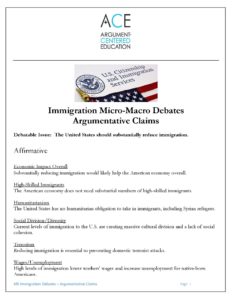
So, each team will both build and defend an argument on the sub-issue, and they will critique and attempt to refute the opposing side’s argument on the sub-issue. In this way, the major facets or subsidiary topics on an issue of the size and complexity of immigration will all be covered during the course of the full Micro-Macro Debates. To give you a concrete example of the claims that teams are given (in the above document) from which they will build their arguments, the humanitarianism sub-issue for the affirmative is given this claim to build out:
The United States has no humanitarian obligation to take in immigrants, including Syrian refugees
While the negative team that has been assigned the terrorism sub-issue is given this claim to build out:
Immigration is not directly related to the terrorist threat against the U.S.
Remember that both sides have to develop counter-arguments, too, against their opposing team’s argumentative claim.
Teaching and Learning Content and Preparing for the Immigration Debates
In teaching content about immigration and the sub-issues that the project has designated, we recommend that after students have been given an overview of the project, including being introduced to the debatable issue and the Micro-Macro Debates format, you conduct an vocabulary building activity.
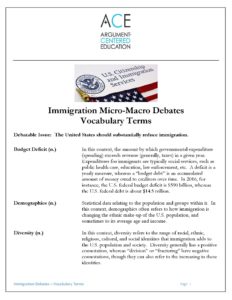
An activity that we have had good success with, on this debatable issue and others, has been the Vocabulary Crowd-Sourcing Activity, which we will discuss in a separate post.
When students have been divided into sides, and further sub-divided into teams, with each team assigned a sub-issue, they should move into the reading and research stage of the project. This begins with the dissemination of a Media List, with affirmative and negative sources on each of the six sub-issues for the debates.
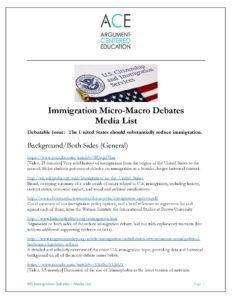
One of the practical questions we face when students are reading and researching sources from our Media Lists is whether the students will have ready access to these sources on line (via the links that appear on the list) or whether they will need to have the articles printed out. Working on this project recently with one of our partner schools, they wanted to have the articles put into documents and printed, which we worked with them to accomplish.

Similarly, we face a practical question over whether the videos on the Media List can be streamed in the classroom, either for the full class or by individual teams of students, or whether it is better that they are downloaded from the internet and placed in a centrally accessible folder, for instance on Google Drive. With this same partner school we downloaded the videos — such as the “immigration and gumballs” video below — and then uploaded them on to Google Classroom.
Another question that has to be asked in designing and implementing argumentation and debate projects like this one is whether students will be reading and researching sources that support the other side’s overall position or, as is relevant for Micro-Macro Debates, sources on sub-issues other than the one that they have been assigned. Argument-based reflection questions like those below help guide students to thinking through the arguments, evidence, and refutation utility of each source they research, so what we decided to do with this same partner school was to have students read all of the sources, affirmative and negative, on their assigned sub-issue, and to prepare responses to the reflection questions that they presented to the class. Students thereby became very familiar with sources on both sides of their sub-issue and at least introduced to the arguments and ideas in the sources on other sub-issues.

Immigration Argument Building: Contentions and Rebuttals
Of course, students are reading and researching with the goal of learning more about the immigration issue, and specifically their sub-issue, and with the concrete objective of building their argument and counter-arguments. For this format, we call the argument they are building a contention, which simply means an argument with multiple pieces of evidence. Since teams of students are only building a single argument, it is especially important that they are very well evidenced.
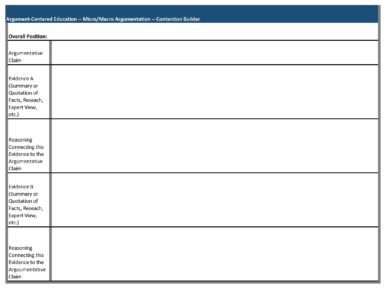
Students also need to be building counter-arguments, which in this format (as in some other formats) are called rebuttals. Rebuttal arguments come in two broad categories. One is called a critical counter-argument. This is the type of counter-argument that addresses and finds the flaws in and critiques the evidence and reasoning in the original argument. The other is called an independent counter-argument. Both types of rebuttal argument can be built within the Rebuttal Builder.

All of these preparation steps are included in the Implementation Plan that we design for projects like the Micro-Macro Immigration Debates. The one below is a sample from an extensive, multi-week implementation of this project earlier this school year at one of our partner schools.
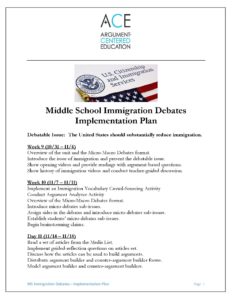
Implementation obviously encompasses the culminating Micro-Macro Debates themselves, the format to which we will now turn.
Micro/Macro Debates Format
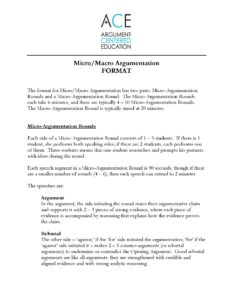
The format for Micro/Macro Argumentation has two parts: Micro-Argumentation Rounds and a Macro-Argumentation Round. The Micro-Argumentation Rounds each take 6 minutes, and there are typically 4 – 10 Micro-Argumentation Rounds. The Macro-Argumentation Round is typically timed at 20 minutes.
Micro-Argumentation Rounds
Each side of a Micro-Argumentation Round consists of 1 – 3 students. If there is a single student, she performs both speaking roles; if there are two students, each performs one of them. Three students means that one student researches and prompts his partners with ideas during the round.
Each speech segment in a Micro-Argumentation Round is about 90 seconds, though if there are a smaller number of rounds, then each speech can extend up to two minutes.
The speeches are:
Argument
In the argument, the side initiating the round states their argumentative claim and supports it with 2 – 3 pieces of strong evidence, where each piece of evidence is accompanied by reasoning that explains how the evidence proves the claim.
Rebuttal
The other side – ‘against,’ if the ‘for’ side initiated the argumentation; ‘for’ if the ‘against’ side initiated it – makes 2 – 5 counter-arguments (or rebuttal arguments) to undermine or contradict the Opening Argument. Good rebuttal arguments are like all arguments: they are strengthened with credible and aligned evidence and with strong analytic reasoning.
Refutation
The side that initiated the argumentation with the argument comes back and tries to refute the rebuttal arguments. The best refutation is point-by-point, addressing each of the rebuttal arguments and stating why it is disproven by the evidence raised in the Opening Argument, has a logical or some other flaw, or is contradicted by additional reasoning or analysis.
Evaluation
The ‘rebuttal’ side then comes back to try to evaluate the competing and clashing argumentation in such a way that favors its side. In particular this often means that the ‘evaluation’ speech focuses on one or two of the rebuttal arguments that was not sufficiently refuted (or even that was missed entirely – remember, in academic argumentation and debate, silence = assent or concession).
Each Micro-Argumentation Round should be tracked on a tracking form (or ‘flow sheet’) by the instructor/moderator, and that tracking form should be screened by a projector so that everyone can see it. The students performing the Micro-Argumentation Round should be tracking the round themselves by hand on the tracking forms that they use to prepare their first speeches on. And all students can be required to track the rounds too, as an engagement and accountability mechanism.
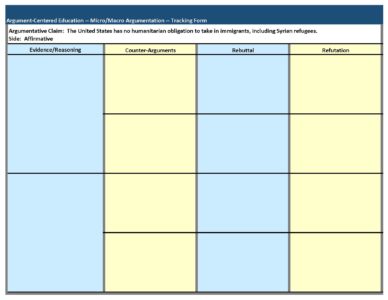
Macro-Argumentation Round
When the Micro-Argumentation Rounds have been completed, the full class comes together for the Macro-Argumentation Round. In this round, the instructor/moderator calls on volunteering student speakers from each side, alternating sides (‘for’ – ‘against’ – ‘for’ – ‘against’), for 90 second speeches that are to evaluate and synthesize the preceding argumentation so that their side is shown to prevail in the debate overall.
This round is generally not tracked on a tracking form, so can be a little less formally structured than the Micro-Argumentation Rounds are. It should demonstrate strong comprehension of and ability in the key argumentation components, though: summary, content knowledge, argumentative claims, evidence, refutation, evaluation.
Determining a Winning Side
The instructor/moderator should determine the winner of each Micro-Argumentation Round and announce it immediately following each round. She should keep a tabulation of which side has how many of these one-point round wins on a Micro-Macro Debates Score Tracker.
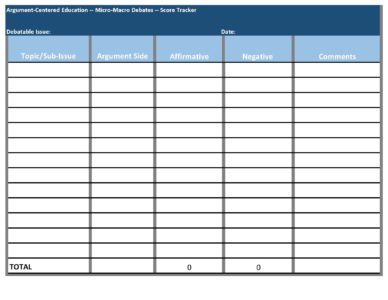
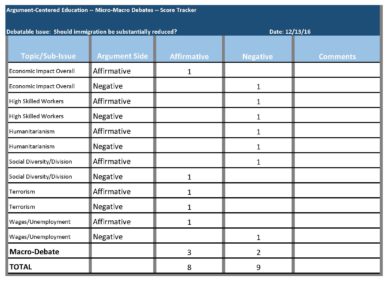
The Macro-Argumentation Round is worth a total of five points, though these can be divided between the sides. So a very close Macro-Argumentation Round can go 3 – 2 for one of the sides. A less close round goes 4 -1 for one of the sides. And a resounding and definitive debate victory in the Macro-Argumentation Round would be scored 5 – 0. The instructor/moderator announces her verdict immediately after the Macro-Argumentation Round for that round, then announces the very final tally and overall winning side.
In The Debatifier‘s next post, we will discuss some of the strengths, and a few of the areas that could be improved, in recent extensive Micro-Macro Immigration Debates project we helped a partner school implement. You’ll want to take a look at this post, as it will identify some common themes — challenges and successes — that can help us all make our use of college-directed argumentation in the classroom an effort in continuous improvement and progressive, highest-quality education.

